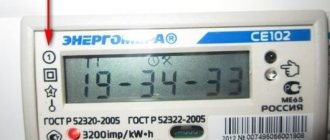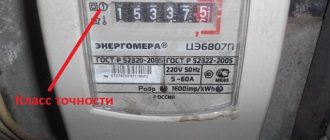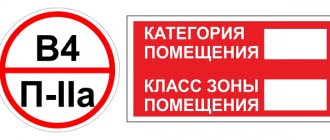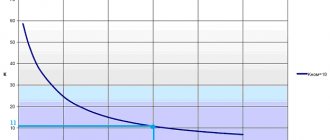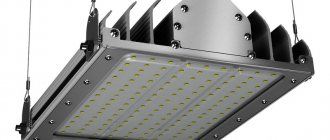Since 2011, electrical goods, equipment and multi-apartment residential buildings must indicate the energy efficiency class
The list included:
- refrigerators,
- washing machines,
- TVs,
- air conditioners (split systems),
- dishwashers,
- vacuum cleaners,
- freezers,
- electric stoves and electric ovens,
- microwaves,
- electrical appliances for heating and heating liquids, boilers, water heaters,
- lamps and fixtures,
- production equipment, machine tools, electric motors and
- multi-apartment residential buildings and buildings.
Here you can learn about the energy efficiency class of an apartment building, the energy efficiency class of lamps and fixtures, and here is a tool with which you can independently calculate the energy efficiency class of a building.
As a rule, manufacturers do not indicate the energy efficiency class on computers, monitors, printers, kettles, and other small equipment.
In this article we will talk about the energy efficiency classes of household electrical appliances.
Types of energy efficiency classes of electrical appliances
To date, 7 main energy efficiency classes have been established: A, B, C, D, E, F, G.
A certain class is assigned to a device depending on the number of kilowatts it consumes.
Each letter is marked on a specific background, the color scheme of which changes from green to yellow and then to bright red.
The letter A, on a green background, means a high level of energy efficiency of the equipment.
Although there are 2 more classes: A+ and A++, indicating higher energy efficiency than class A.
Marking B is applied to devices with a lower energy efficiency rating.
The letters C, D, E, F, G indicate the lowest energy saving class.
A little history
Labeling the energy consumption class of a product has been used in Europe since the 90s of the 19th century. Now the label is used in more than 50 countries around the world. Mandatory energy efficiency labeling has become a key tool for efficient energy consumption and a driving force for reducing the energy intensity of the gross national product. In practice, there are now two energy efficiency labeling systems:
- The American Energy Guide model, which involves analyzing the energy consumption of similar products and selecting from them about 25% with the lowest energy consumption, which are assigned the Energy Guide brand
- The labeling model adopted in the EU countries, which involves dividing all products of the same type into seven classes, from A to G. The same designations apply in Russia. The division is made according to the ranges of quantitative indicators of energy efficiency throughout the entire range of characteristics from the most economical to the most energy-wasting
The main levers of influence of energy efficiency labeling on the energy intensity of the economy include:
- restrictions on the export of energy-intensive products (the import of products of classes F and G into the EU countries is prohibited, and temporary restrictions have been introduced on the middle classes D and F)
- linking energy efficiency with carbon dioxide emissions into the atmosphere, implying the inclusion of labeling in the system of sales of air emission quotas
- a system of fiscal measures to limit the production and sale of energy wasteful equipment
- state support for those enterprises that are focused on using energy-efficient goods in the production
- discounts for consumers choosing energy efficient technologies
- promotion of energy saving and respect for the environment
How is the energy efficiency indicator calculated?
The energy efficiency class is calculated for each type of device based on different parameters.
For a washing machine, the energy efficiency indicator is the ratio of the power consumed per hour to the maximum load volume.
For class A washing machine, this value should be in the range of 0.17 - 0.19, for class B 0.19 - 0.23, and so on.
If several letters are indicated on the machine, it means that the energy saving classes for spinning and washing are also set for this device.
To calculate the energy consumption class of refrigerators, the volume of the chambers, the minimum possible temperature inside them, and the presence of additional options in the device (automatic defrosting, etc.) are taken into account.
The highest energy saving class that can be assigned to a refrigerator, like a washing machine, is A++.
For electric ovens, the energy efficiency class is determined based on the power and volume of the oven chamber.
At the same time, different ranges of energy saving values are provided for ovens of different sizes.
The energy efficiency class for air conditioners is calculated taking into account their functionality.
Single-channel or two-channel split system, whether or not there is a water and air cooling system, the presence of cooling and heating modes.
Different air conditioners have different values for determining the energy class.
The energy efficiency class for TVs is defined as the ratio of power consumption to screen size.
A dishwasher's energy efficiency index is a rating of the efficiency of washing and drying separately.
Thus, knowing the energy efficiency indicator of a household electrical appliance, you can purchase more economical products and, thereby, significantly reduce your energy costs.
And today, in the context of constantly rising prices for electricity, this is more than relevant for every consumer of energy resources.
Now let's look at the energy efficiency classes of individual household appliances.
From A+++ to G: energy efficiency classes of household appliances
During the implementation phase, energy efficiency classes were designated by symbols A to G on a colored background (green to red). This marking is easy to decipher: the closer the letter is to the beginning of the alphabet, the more efficient the device’s energy consumption
. Subsequently, it was possible to exclude the symbols E, F and G from most categories due to their withdrawal from the market due to high wastefulness and introduce a couple of new indices: A+, A++ and A+++, identifying devices with maximum energy efficiency.
| The place of the wasteful symbols E, F and G in the marking of energy efficiency classes has been taken by the more current indices A+, A++ and A+++. |
A mark indicating the energy efficiency class of household appliances is placed on refrigerators, dishwashers, washing and drying machines, ovens, hoods, televisions, air conditioners, vacuum cleaners, water heaters and even some types of light bulbs (with a luminosity of 6500 lumens and a power of over 4 W). You can find the treasured letter on an information sticker or in the characteristics of a particular device (including using filters to search in household appliance catalogs). The Energy Label sample has been approved by the European Association of Household Appliance Manufacturers (CECED). The main thing on them is the indication of the energy consumption class on the corresponding color background.
At the same time, the label indicates the key performance characteristics of the equipment, which vary depending on the category of device. For different groups of equipment, the energy efficiency scale is calculated according to different criteria. We will look at them:
Refrigerators and freezers
Food storage plays one of the most important roles in the house. Their energy consumption is important like no other. The thing is that refrigerators and freezers work non-stop, i.e. 24 hours a day, 7 days a week. The energy efficiency indicator of refrigerators is calculated taking into account the volume of the chambers, the minimum possible temperature inside them and the presence of additional options in the device.
It may well be that some giant refrigerator, although it consumes more electricity than its compact counterpart, nevertheless belongs to a higher class of energy efficiency.
The Energy Label also contains information about the brand and model of the refrigeration unit, annual energy consumption, internal volumes of the freezer and refrigerator compartments, and noise level in decibels. The most energy efficient refrigerators Samsung RB38T672CWW from 21,299 UAH. Liebherr CP 4813 from 14,799 UAH. Samsung RB36T672CS9 from 16,100 UAH. Liebherr CBNes 4898 from 68,641 UAH. Gorenje NRC 6204 SXL5M from 16,380 UAH. Samsung RB41R7839S9 from 35,796 UAH. Liebherr CP 4313 from 12,999 UAH. Hisense RB-438N4GX3 from 14,994 UAH. Samsung RB36T602CSA from 14,606 UAH. Bosch KGE39AICA from 19,445 UAH. Bosch KGE49EICP from 22,313 UAH. LG GB-B62SWGFN from 14,699 UAH. LG GB-B61PZFFN from 16,358 UAH. Samsung RB36R8899SR from 25,650 UAH. Samsung RB38T775CS9 from 23,114 UAH. Liebherr K 4330 from 24,589 UAH. Whirlpool BTNF 5323 OX from 18,872 UAH. Whirlpool W9 931D KS from 17,199 UAH. Siemens KG49NAXDP from 26,099 UAH. Samsung RB36T675CS9 from 22,136 UAH.
Dishwashers
The calculation of the energy efficiency class of dishwashers is based on the ratio of actual electricity consumption to standard, which directly depends on the number of sets of dishes loaded into the device. also influenced by the efficiency classes of the washing and drying cycles separately
. The European Energy Label for dishwashers is marked with symbols A+++ to D.
In addition to the traditional model and energy efficiency class, the sticker informs the user about the annual energy consumption (kW/year), drying quality class (from A to G), nominal load (number of standard cutlery sets) and noise level in decibels.
The most energy efficient dishwashers
Hotpoint-Ariston HSFO 3T235 WC X from 8,951 UAH. Samsung DW60R7050FS from 16,766 UAH. Siemens SN 278I36 from 26,708 UAH. Candy Brava HCF 3C7LFX from 8,779 UAH. Siemens SR 23HI65 from 14,575 UAH. Candy Brava HCF 3C7LFW from 8,999 UAH. Bosch SMS 4EVW14E from 15,714 UAH. Bosch SPS 66TW01E from 18,865 UAH. Bosch SPS 66TI01E from 15,645 UAH. Bosch SMS 88UI36E from 26,813 UAH. Bosch SPS 6ZMI35E from 18,425 UAH. Beko DFN 38530 X from 13,356 UAH. Siemens SR 256I01 from 17,190 UAH. Beko DFS 28131 X from 12,881 UAH. Electrolux ESF 8635 ROX from 17,849 UAH. Electrolux ESF 5545 LOX from 13,300 UAH. Candy Brava CDPN 4D620PX from 13,688 UAH. Whirlpool WSFO 3O34 PF X from 12,112 UAH. Bosch SMS 4EVI14E from 14,410 UAH. Beko MDFN 26431 X from 11,268 UAH.
Washing machines
For a group of “washing machines”, the energy efficiency class is determined by the ratio of power consumed per hour to the maximum weight of loaded laundry
. Previously, the label also included data on the washing efficiency class, however, according to the new CECED rules, all washing machines with a load of more than 3 kg of laundry are required to have the only possible washing class A.
Related information on the label includes the full name of the washing machine model, annual energy and water consumption, maximum load of laundry (in kg), spin efficiency class (from A to G), noise level during washing and spinning (separately for each procedure).
The most energy efficient washing machines
Samsung WW60J32G0PW from 8,428 UAH. Whirlpool TDLR 65230 from 8,118 UAH. Samsung WW80R42LHFWD from 10,440 UAH. Beko WUE 6511 XAW from 5,362 UAH. LG FH0J3NDN0 from 8,893 UAH. Whirlpool TDLR 6030 L from 6,199 UAH. Samsung WW90TA047AE from 12,735 UAH. LG F2J3WS2W from 9,755 UAH. Samsung WW60J42E0HW from 9,710 UAH. Electrolux PerfectCare 600 EW6S4R27W from 6,999 UAH. Electrolux PerfectCare 600 EW6S326SUI from 7,979 UAH. Electrolux PerfectCare 600 EW6S426BUI from 7,390 UAH. Bosch WAN 28162 from 9,775 UAH. LG F2J6HS1W from 12,403 UAH. Samsung WW70R62LATW from 15,793 UAH. Electrolux PerfectCare 600 EW6S4R27BX from 8,499 UAH. Samsung WW60K42101W from 9,145 UAH. Bosch WLT 24460 from 13,694 UAH. Electrolux PerfectCare 600 EW6T4062U from 10,573 UAH. LG F2J3HN1W from 8,999 UAH.
Dryers
Close relatives of washing machines can be marked with one of three stickers: for models with ventilated drying, condenser drying and rare models powered by gas, their own version of the label is provided
. For example, the energy efficiency class of condensation dryers is determined based on information about the energy consumption of the machine when running the “Cotton” program with a full and partial load, as well as in standby mode and in a completely off state.
A set of extended information on the tag contains data on the brand of the dryer, its type, annual energy consumption, the duration of the “Cotton” program at maximum load of laundry, full load (in kg), noise level in decibels and moisture condensation efficiency class (symbols from A to G).
The most energy efficient dryers
Samsung DV90T6240LX from 12,200 UAH. Samsung DV90T8240SH from 17,119 UAH. Samsung DV90T5240AT from 14,999 UAH. AEG T9DBA68SC from 32,999 UAH. Bosch WTR 87TW0 from 17,487 UAH. LG RC80U2AV4D from 14,250 UAH. LG RC90V9AV3Q from 18,450 UAH. Siemens WT 47XEH1 from 31,199 UAH. LG DC90V9V9W from 29,300 UAH. LG RC90V9AV2Q from 22,132 UAH. Asko T408HD from 40,000 UAH. Siemens WT 47RTE0P from 19,930 UAH. LG RC90V9JV2W from 29,100 UAH. Samsung DV80T5220AE from 16,914 UAH. Electrolux PerfectCare 900 EW9H189BP from 31,859 UAH. Samsung DV90M6200CW from 17,459 UAH. Bosch WTX 87EH0 from 34,432 UAH. Electrolux PerfectCare 900 EW9H188SPC from 29,551 UAH. Beko MDH 8634 RX from 20,954 UAH. LG RC90V9AV4Q from 25,673 UAH.
Ovens
One of the central places in most kitchens is the oven. Its energy efficiency class is determined based on the power and volume of the oven chamber.
Models with an internal volume of less than 18 liters, as well as ovens with a microwave function and steam ovens are not subject to marking.
Along with the energy efficiency scale on the label, you can see data on the name of the oven model, electricity consumption per cycle in static heating mode and in convection mode (kWh), useful internal volume of the oven in liters.
The most energy efficient ovens
Hoods
The list of kitchen appliances that are subject to mandatory “branding” is completed by hoods. The energy labeling system for them was adopted not so long ago - in 2014.
The label on the hood can tell you both about quite obvious things (model name and energy efficiency class of the device) and about a number of useful performance characteristics. The pictrograms on the sticker contain information about the annual energy consumption at a typical load, efficiency classes for removing evaporations from the hob, lighting and grease collection, as well as the noise level during operation of the hood (measured in decibels).
TVs
In everyday life, television is still the center of attraction for household members and the multimedia center of the home. Its energy efficiency is calculated as the ratio of power consumption to screen area
.
The energy efficiency scale contains information about the presence of a switch on board the device to completely de-energize the device, indicators of energy consumption in standby mode and for the year in the on state are indicated, and finally, the bottom of the sticker contains information about the diagonal of the TV display.
Air conditioners
With climate control technology, which provides coolness in the hot summer heat and warms with warm air currents in the off-season, things are somewhat more complicated. It all depends on the set of operating modes (cooling with or without heating), the type of cooling (air or water) and the configuration of the air conditioner
(split and multi-split systems, two-channel and single-channel systems with forced ventilation, etc.). Air conditioner efficiency measurements are made at outside temperatures from +20 °C to +35 °C (in increments of 5 °C), and for the heating mode, the climatic zone in which the equipment is supposed to be operated is taken into account.
A set of additional information on the label includes information about the annual electricity consumption, the type of air conditioner, its power when operating for heating and cooling, and the noise level of the outdoor and indoor units.
The most energy efficient (cooling) air conditioners
Cooper&Hunter Supreme Continental CH-S12FTXAL from 22,325 UAH. Cooper&Hunter Supreme Continental CH-S09FTXAL from 21,534 UAH. Cooper&Hunter Nordic Premium CH-S12FTXN-PW from 22,541 UAH. Cooper&Hunter Nordic Premium CH-S09FTXN-PW from 19,428 UAH. Bosch CL5000i RAC 2.6 from 14,800 UAH. Haier Flexis AS25S2SF1FA/1U25S2SM1FA from 19,000 UAH. Midea BreezeleSS+ FA-09N8D6-I/FA-09N8D6-O from 18,120 UAH. Bosch CL5000i RAC 3.5 from 15,988 UAH. Midea BreezeleSS+ FA-12N8D6-I/FA-12N8D6-O from 19,900 UAH. Mitsubishi Electric Deluxe MSZ-FH25VE/MUZ-FH25VE from 22,296 UAH. Haier Flexis AS35S2SF1FA/1U35S2SM1FA from 19,286 UAH. Mitsubishi Heavy Premium SRK20ZS-W from 18,600 UAH. Mitsubishi Electric Premium MSZ-LN25VG/MUZ-LN25VG from 32,788 UAH. Cooper&Hunter Vip Inverter CH-S12FTXHV-B from 26,500 UAH. Neoclima Skycold Nordic NS/NU-09ESNIw1 from 13,982 UAH. Mitsubishi Heavy Premium SRK25ZS-W from 19,800 UAH. Midea Oasis Plus OP-09N8E6 from 21,120 UAH. Mitsubishi Electric Deluxe MSZ-FH35VE/MUZ-FH35VE from 35,918 UAH. Neoclima Alaska 2.0 NS/NU-09AHTIw from 15,300 UAH. Midea Oasis Plus OP-12N8E6 from 21,120 UAH.
Vacuum cleaners
Home front cleaners are among the appliances for which energy efficiency labeling was introduced in 2014. It looks like this:
The data on the label includes the appliance's annual energy consumption, indoor dust re-emission class (A to G), noise level in decibels, and cleaning efficiency classes for hard floors and carpets.
respectively.
Water heaters
Energy labeling is used both for autonomous boilers and boilers, and for complex devices
which are supposed to be used in combination with additional heating equipment. The sticker for devices of this type covers, perhaps, the maximum possible parameters.
The marking on the label with the water heater contains information about the brand and model of the product, the presence of heating and water heating functions in the device’s assets, the seasonal energy efficiency class of water heating for heating and the hot water supply circuit, the rated thermal power and the generated noise level in decibels.
As you can see, each type of household appliance has its own specifics. Our advice to you: focus on devices of class A and higher
. By paying attention to the energy efficiency indicator when choosing home appliances, you can furnish your home with economical models, thus reducing energy costs in the foreseeable future.
Refrigerators
The energy efficiency of refrigerators is calculated taking into account several parameters:
- volume of refrigerator and freezer compartments,
- minimum possible temperature in both chambers,
- the presence of additional functions, for example, No Frost, display, Wi-Fi and others.
The most energy efficient, as we found out, are class A+++ models.
Refrigerators with high energy efficiency are more expensive.
However, there is no point in saving, since a more expensive, high-end model will quickly pay for itself.
This technique works around the clock.
For example, Samsung RL-44 QEUS class “A+” with a volume of 326 liters consumes 315 kW/h throughout the year.
The Biryusa 22 model with a volume of 250 liters, belonging to class C, consumes 548 kW/h per year.
As a rule, manufacturers indicate not only the energy saving class, but also the annual electricity consumption in kW/h.
Keep in mind that in order for the energy efficiency class of the refrigerator to correspond to that declared by the manufacturer, it must be installed in accordance with the instructions in the instructions.
Firstly, the equipment must be positioned horizontally, and secondly, it is necessary to provide a certain gap between the walls of the refrigerator and the wall or surrounding furniture.
What does the economical use of household appliances provide?
It happens that it is not possible to immediately optimize energy consumption, especially if you previously used household appliances contrary to the given tips and recommendations. Breaking your habits is not easy, but the results are worth it. By gradually following the advice, you will notice a decrease in your energy bills, and this will already be an additional incentive to optimize the energy consumption of your equipment.
In addition to the financial benefit for yourself, you will contribute to preserving the environment. Electricity production takes its toll on the environment, creating threats of global warming and the greenhouse effect. Such phenomena lead to an increase in the number of natural disasters and cataclysms. Many people do not realize that the normal use of household appliances can somehow affect the environmental situation of the planet. Numbers will help clarify the situation.
Saving one kilowatt hour by one household results in savings of 4 to 6 kWh at the electricity generating facility. The global average of kW/h production is associated with the emission of about 800 g of CO2 into the atmosphere. It turns out that household appliances with energy consumption class “A+” consume an average of 190 kW/h per year. As a result, CO2 emissions are reduced by up to 200 kg compared to the use of devices classified as “B” class.
Consider the energy consumption classes of household appliances when purchasing new appliances and use them wisely. As a result, reducing the energy consumption of home devices will benefit not only the family budget, but will also help preserve the environment on the planet.
Energy efficiency class of washing machines
The energy efficiency of washing machines is calculated as the ratio of power consumption per hour to the maximum load volume.
Washing machines are available in class A with several advantages.
However, purchasing a model with a higher energy saving class is not always advisable.
If the refrigerator works around the clock, then the washing machine only works a few hours a week.
Therefore, the difference between the energy efficiency of model A and A++/class will be almost invisible.
The difference in their cost is quite significant, so it is unlikely to pay for itself.
Of course, this does not mean that you should choose BD class models, since their level of energy efficiency can already be classified as critically low.
In addition, it should be taken into account that the class affects not only energy consumption, but also the quality of washing.
If a machine consumes a minimum of energy within an hour, but at the same time, after a long wash, leaves dirt on the laundry, it cannot be called energy efficient.
The quality of washing is determined as follows:
- contaminated fabric of a certain size is loaded into the machine,
- the flap is washed for an hour with a water temperature of 60 degrees,
- The washed fabric is compared with the standard.
TV energy efficiency class
Televisions, like refrigerators, are appliances that are used frequently, so you shouldn’t skimp on the energy saving class.
The energy efficiency class of a TV is calculated by determining the ratio of power consumption to screen area.
Power consumption is taken into account not only while the TV is operating, but also in standby mode.
In addition, this indicator is also affected by the presence of additional options, for example, several tuners, built-in storage, Wi-Fi, etc.
Note that class A+ models appeared only four years ago, and class A+++ TVs are expected only in a couple of years.
The most common models today are class A and A+.
The latter includes a Sony KDL-40W705C TV.
Old TVs with a cathode ray tube, as well as modern plasma ones, are the least energy efficient.
TFT models are considered the most energy efficient today.
Which buildings are not subject to energy efficiency and rating requirements?
An energy passport is required by law for all new and reconstructed buildings and premises that have undergone major renovations. But paragraph 11 of the Federal Law “On Energy Saving” provides a list of exceptions.
Buildings that are not subject to the requirements:
- Structures classified as cultural heritage sites.
- Buildings intended for temporary use (up to 2 years).
- Private residential buildings (up to 3 floors).
- Auxiliary facilities.
- Separate buildings and structures whose area does not exceed 50 square meters.
An energy passport is not required for the listed buildings. They are operated without being assigned an energy efficiency level.
Air conditioner energy efficiency class
Calculation of the energy efficiency of an air conditioner is carried out using a complex algorithm, since the cooling and heating coefficients are taken into account simultaneously.
The coefficients are determined by the amount of thermal energy that is released within an hour when the device is operating at 100% load.
The coefficients show how many times the thermal power exceeds the power consumption of electricity.
For class A the coefficients are >3.2-3.6, and for class B the coefficients are in the range >3.0-3.2.
Due to the fact that the weather in Europe began to differ greatly from the norm, the concept of seasonal indices (SEER and SCOP) was introduced, which take into account temperature deviations from the norm, as well as other factors.
Here you can learn more about the classes and energy efficiency of air conditioners.
The influence of third-party factors on energy consumption
The electricity consumption of a refrigerator depends not only on the quality of its components, but also on external factors. These factors can be excluded, but for this the device must be in optimal conditions for it.
The main problem is that the manufacturer calculates energy consumption under ideal conditions, which often do not coincide with reality. You can read more about this in the instructions.
Room temperature
Most refrigeration appliances are designed to operate at +20℃. As the temperature drops or rises, electricity consumption will increase. For example, at 0℃ the device will consume 1.5 times more energy, and at +30℃ – 2 times more.
Camera workload
Equipment manufacturers recommend refraining from fully loading devices. It is also advisable to distribute food on shelves, since fully loading one shelf will have a bad effect on the operation of the refrigerator.
Timely service
Maintenance means defrosting. The exception is models equipped with an automatic system for removing melted ice. Due to snow build-up inside the chamber, heat transfer suffers and energy consumption increases.
Dishwashers
The energy efficiency of dishwashing machines is determined by taking into account energy consumption in standby mode and after 280 wash cycles.
The resulting value is correlated with average energy consumption.
The average value is taken to be 462 kWh of electricity per year, which is spent on washing a certain amount of dishes.
The highest class, that is, A+++, has an index of 50 or less.
Devices of lower classes can have a coefficient of up to 90.
Energy class: what does it mean?
The energy saving class of refrigerators is an indicator that determines the amount of electricity consumed by the appliance during operation. The lower the energy consumption, the lower the amount to be paid for electricity in the receipt. This directly applies to refrigerators - they work around the clock, year after year.
European scientists have created a letter classification of the energy consumption of refrigerators, microwaves, washing machines and dishwashers. The result was a system of letters from A to G in increasing order from the most economical to the most “costly”.
The category indicates what percentage of electricity a particular device consumes from the average consumption in its group for the year. Let's consider what category “A” means in a refrigerator: compared to the average, the device consumes a maximum of 55% of energy per year, equipment with the “G” indicator exceeds the conventional norm by 150%.
Attention! Even if the refrigerator does not correspond to the first letter of the Latin alphabet, you should not consider it of poor quality - categories B and C are also economical, since they consume 75% and 95%, respectively, of the norm, this figure is still less than 100%.
Computers
Computers are not assigned an energy efficiency class, since they are complex equipment, the coefficient of which is almost impossible to calculate.
Different PC components may have different performance and energy efficiency.
The more powerful the computer, the more energy it consumes.
This is especially true for gaming models with high-performance video cards.
However, it should be borne in mind that manufacturers of computer components are also striving to increase energy efficiency and reduce heat generation of their products.
Therefore, the most powerful modern video card will always consume less energy than, for example, a video card of the same class, but ten years ago.
Another important element of a computer that significantly affects energy consumption is the power supply.
It is advisable to purchase PCs with 80 PLUS class power supplies, which are currently the most energy efficient.
It follows that from time to time computer equipment should be updated not only in order to increase its performance, but also to improve energy efficiency indicators.
Monitors
Monitors, like computers, are not assigned an energy efficiency class, but this indicator is more stable than that of computers.
On average, modern monitors have the following power consumption:
- 18-20” – 12 W
- 21–22” – 17 W
- 23–24” 19 W.
To choose the most energy-efficient monitor in its class, pay attention to the power consumption, which is indicated in the specifications.
The most energy efficient are monitor models with LED backlighting.
Don't forget that the monitor consumes power even when it is in sleep mode, that is, when the screen is off but the LED is on.
Printers
Printers, like monitors, are not assigned an energy efficiency class, so they should be selected taking into account the power consumption, which varies for different types of equipment:
- inkjet printers – 25-40 W/h.
- laser printers – 350-400 W/h.
In addition to energy consumption, printing speed is an important parameter.
Laser printers are not always less energy efficient than inkjet printers, since their printing speed is much higher.
You can independently calculate the energy efficiency of a printer as the ratio of power consumption and the number of printed pages per hour.
The least energy efficient are multifunction devices that include a printer and scanner.
This is due to the fact that if you use the printer in standby mode, the scanner also works.
For a home where the printer is rarely used, its energy efficiency does not play a special role.
The only thing to remember is that it consumes several watts of electricity even in standby mode.
Vacuum cleaner energy efficiency class
The energy efficiency gradation is the same as for other energy appliances, but only up to class D.
Models of class E, F and G are no longer available for sale.
Vacuum cleaners designed for cleaning hard surfaces and carpets are assigned two energy efficiency classes.
As in the case of washing machines, the energy efficiency class speaks not only about energy consumption, but also about the cleaning efficiency, that is, the dust content in the air after cleaning surfaces with a vacuum cleaner.
As a rule, the manufacturer indicates not only the energy efficiency class of the device, but also the electricity consumption per year in kW/h.
This figure is based on 50 cleanings per year, performed in a room of 87 square meters.
Economical use of the washing machine
Automatic washing machines don't work like a refrigerator all the time, but when they wash, the electric meter is significantly boosted. This happens because several energy-consuming operations are performed. Heating the water, the spinning process, and if the machine also has a clothes dryer, then a lot of kW will be consumed in one washing cycle.
Washing machines also have energy consumption classes, which are designated by a similar gradation as refrigerators. The machines also have a class for drying clothes, if the model has such a function. When choosing a new laundry assistant, be sure to look at the class of the model you like.
Saving on the use of a washing machine is quite simple. For one wash, load the volume of laundry close to the maximum allowable. Washing several light items on long programs is irrational. Don’t forget about express wash modes, which adequately cope with many soiled clothes. Also, don't go to extremes in trying to reduce your washing machine's energy consumption. Do not exceed the permissible amount of laundry per wash.
In many ways it is similar to a washing machine. You can save kW using a dishwasher using special eco modes, which require a full load and washing in slightly hot water. True, it will be difficult to wash heavily soiled dishes in this mode.
Freezers
The energy efficiency class of a freezer is calculated in the same way as a regular refrigerator, that is, the volume, minimum temperature and the presence of additional options that increase energy consumption are taken into account.
The gradation is also similar to refrigerators - the energy consumption of class A+++ models is less than 22 kW.
A-class models consume 44-55 kW, while B-class freezers consume 55-70 kW of electricity.
The energy efficiency of a freezer depends on the location and quality of installation (just like the energy efficiency of a refrigerator).
If your freezer is not installed correctly, it will consume much more electricity than it should.
Class confirmation
The specific annual consumption of energy resources is confirmed by:
- no later than 3 months before the expiration of 5 years from the date of commissioning of the apartment building - for houses built or put into operation;
- additionally no later than 3 months before the expiration of 10 years from the date of commissioning of the MKD - for MKD of the highest energy efficiency classes.
As for the energy efficiency class, for an apartment building in operation, it is indicated no later than 3 months before the expiration of 5 years from the date of issue of the energy efficiency class act.
The class confirms the decision of the owners of the apartment building premises or the initiative person managing the apartment building. The energy efficiency class of MKD is confirmed no more than once a year.
If the class is not confirmed, then it cannot be indicated in the technical documentation, on the facade of the apartment building or on information stands.
How commercial heat energy metering occurs, read our article.
Electric stoves
The energy efficiency class of electric stoves shows the electricity consumption per hour when all burners are operating at full power.
Cookers that consume 0.6-1 kW/h are considered economical.
Low-end models consume 1.6/2.0 kW/h.
This information is also relevant for electric ovens.
The only thing is that when calculating its energy efficiency, volume is also taken into account.
If the hob is combined with an electric oven, the passport indicates two energy efficiency classes, that is, for each element separately.
The energy saving class of electric ovens is determined taking into account the power consumption and volume of the oven chamber.
Induction furnaces are the most energy efficient.
Their energy is spent directly on heating the dishes, rather than heating the burner and heating the space around the stove.
However, the cost of induction cookers is the highest.

